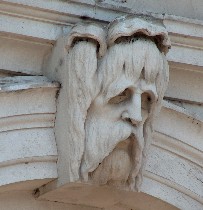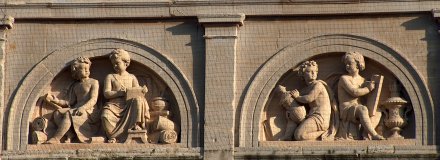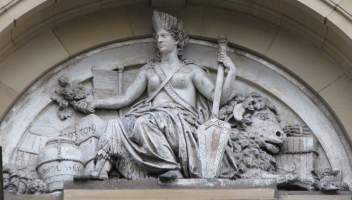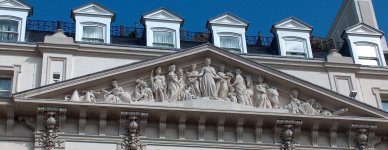Victorian Sculptors
John Thomas (1813-1862)
A marine keystone by John Thomas.
'The wonderful facility of invention displayed by Mr Thomas, his rapidity of execution, and his great knowledge of every department of ornamental and architectural sculpture, as well as of interior decoration, caused him to be extensively employed by many of the leading architects in the country, and also by many owners of mansions who consulted him about furniture and fittings.'
The sculptor John Thomas is not well known today, but he was one of the more prolific Victorian sculptors, responsible for much important architectural sculpture and a variety of statues, busts and ideal works. He also worked as an architect, designing, among other buildings, Regents Park Chapel.
John Thomas was born in Chalford, Gloucestershire, apprenticed to a local stone mason, and afterwards went to Birmingham. Coming to the attention of Charles Barry for a Gothic monument he had made for Huntingdon, he was employed by the great architect firstly on ornament for Birmingham Grammar School, and later, on the Houses of Parliament, where he was responsible for all the statues on the South and North fronts, and those on the Victoria Tower, as well as two statues inside. He exhibited at the Royal Academy from 1842 to 1861, and his final works were shown at the Great Exhibition, which, it seems, was at least partly the cause of his early death. As recounted at the time:
'Mr Thomas’s death was… hastened, we believe, by disappointment. The facts, as related to us on good authority, are, that the Royal Commissioners, or their agents, had, after considerable discussion with him, and not of the most conciliatory nature, refused him space for [his] Shakspere Monument. For two or three weeks previously he had been much indisposed, from over labour and anxiety; he went home after his last interview with the authorities at Kensington, took to his bed, and died within a very few days.'
John Thomas’s sculpture is to be admired for its extremely wide variety and consistent high degree of competency. He seems to have overflowed with imagination, as shown by the many small details he delighted in adding to his architectural figures. His portraiture too, is good, and a personal favourite of mine is the sympathetic bust of G. P. Watkins in the Cardiff Museum, a slightly sad, careworn man in the spirit of the Ashmolean’s noble Roman.
One of the figures on the Free Trade Hall, Manchester..
Apart from the Houses of Parliament figures, in London, John Thomas was the sculptor of the pediment of Paddington Station Great Western Hotel, decorative work on the piers of the entrance gates of Buckingham Palace, the United Services Club frieze, the figures and decorative vases by the Hyde Park fountains, and the statue of Hugh Myddleton in Islington. In Manchester, the excellent figure sculpture on the Free Trade Hall is his. In Bristol, he did the sculpture for the Fine Arts Academy and the Law Courts, and on the former West of England and South Wales District Bank (pictured on this page), and his also the pedimental sculpture for Halifax Town Hall and Leeds Town Hall. And surely his Lady Godiva in the Maidstone Museum must be the best of breed for this popular subject; in that same town is his statue of Queen Victoria. The picture below (click to enlarge) is of the Great Western Hotel pediment, which unfortunately I had to take at an angle because the street is too narrow to get a good picture straight on.



